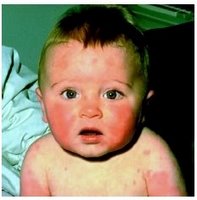Fifth disease overview
|
Fifth disease Microchapters |
|
Diagnosis |
|---|
|
Treatment |
|
Case Studies |
|
Fifth disease overview On the Web |
|
American Roentgen Ray Society Images of Fifth disease overview |
|
Risk calculators and risk factors for Fifth disease overview |
Editor-In-Chief: C. Michael Gibson, M.S., M.D. [1]
Overview
Fifth disease, sometimes called erythema infectiosum, is a mild rash illness caused by a viral infection that occurs most commonly in children. The ill child typically has a "slapped-cheek" rash on the face and a lacy red rash on the trunk and limbs. Occasionally, the rash may [[itch]. An ill child may have a low-grade fever, malaise, or a "cold" a few days before the rash breaks out. The child is usually not very ill, and the rash resolves in 7 to 10 days.
Historical Perspective
Fifth disease is also referred to as erythema infectiosum (meaning infectious redness) and as Human Parvovirus B19 Infection,Slapped cheek syndrome, Slapcheek, Slap face or Slapped face. It is a mild rash illness that occurs most commonly in children. The name "fifth disease" derives from its historical classification as the fifth of the classical childhood skin rashes or exanthems. In 1975, the cause of Fifth disease was discovered to be parvovirus B19.
Pathophysiology
A person infected with parvovirus B19 is contagious during the early part of the illness, before the rash appears. By the time a child has the characteristic "slapped cheek" [[rash] of fifth disease, for example, he or she is probably no longer contagious and may return to school or child care center. This contagious period is different than that for many other rash illnesses, such as measles, for which the child is contagious while he or she has the rash.
Parvovirus B19 has been found in the respiratory secretions (e.g., saliva, sputum, or nasal mucus) of infected persons before the onset of rash, when they appear to "just have a cold." The virus is probably spread from person to person by direct contact with those secretions, such as sharing drinking cups or utensils. A susceptible person usually becomes ill 4 to 14 days after being infected with the virus, but may become ill for as long as 20 days after infection.
Causes
Fifth disease is caused by infection with human parvovirus B19. Human parvovirus is a linear, non-segmented single-stranded DNA virus.
Epidemiology and Demographics
Parvovirus infections are most common in children aged five to fifteen years and outbreaks can arise especially in nurseries and schools.
Risk Factors
Anyone can get Fifth disease. Once anyone has had it, they become immunized against the virus. Because the virus is so common, most people acquire immunity in childhood. The disease is not very serious unless the person infected has conditions (problems with immune system, pregnancy, sickle-cell disease, anemia)
Diagnosis
History and Symptoms
The first symptoms of fifth disease are usually mild and nonspecific including fever, runny nose and headache followed by development of a "slapped-cheek" rash on the face and a lacy red rash on the trunk and limbs.
Physical Examination
Skin
Bright red cheeks are a defining symptom of the infection in children (hence the name "slapped cheek disease"). Occasionally the rash will extend over the bridge of the nose or around the mouth. In addition to red cheeks, children often develop a red, lacy rash on the rest of the body, with the upper arms and legs being the most common locations.

Laboratory Findings
A physician can often diagnose fifth disease by seeing the typical rash during a physical examination. In cases in which it is important to confirm the diagnosis, a blood test may be done to look for antibodies to parvovirus. Antibodies are proteins produced by the immune system in response to parvovirus B19 and other germs. If immunoglobulin M (IgM) antibody to parvovirus B19 is detected, the test result suggests that the person has had a recent infection.
Treatment
Medical Therapy
Treatment of fifth disease is mainly symptomatic. Adults with joint pain and swelling may need to rest, restrict their activities, and take medicines such asaspirin or ibuprofen to relieve symptoms.
Primary Prevention
There is no vaccine or medicine that prevents parvovirus B19 infection. Frequent handwashing is recommended as a practical and probably effective method to decrease the chance of becoming infected.